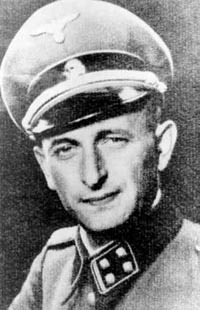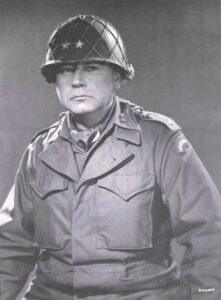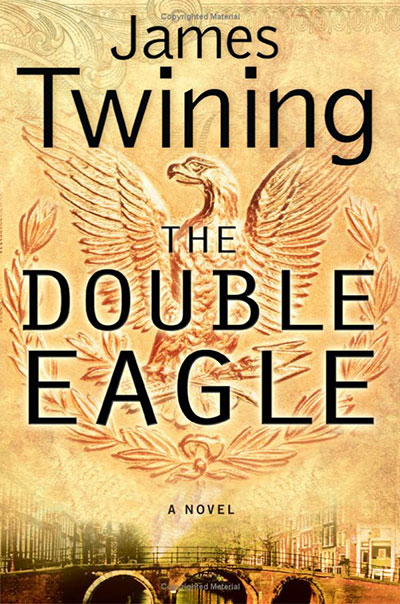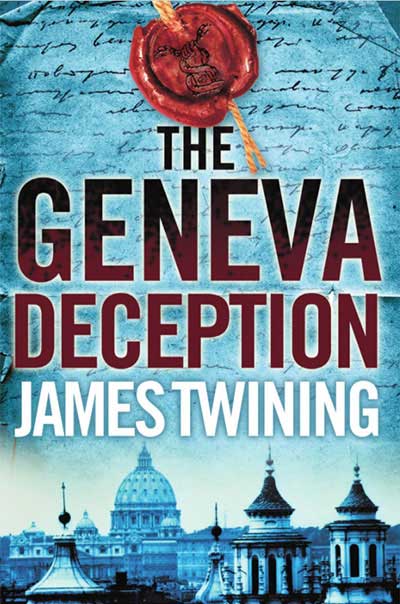The story of the Hungarian Gold Train
In December 1944, as the Third Reich entered its final death throes, Adolf Eichmann, the architect of the Final Solution, ordered a train to be prepared. This was to be no ordinary train, however – twenty-nine of its fifty-two carriages were heavy-duty and, in some cases, specially reinforced freight cars, the best that the Nazis could lay their hands on at the time.
Its purpose was to carry the vast amounts of gold, art and other valuables stolen by the Nazis from Hungary’s murdered Jewsish population across a hostile and smouldering landscape to the safety of neutral Switzerland.
It was a journey that was to end more than sixty years later, in an air-conditioned Miami courthouse.
***
A train is prepared
In December 1944, with the Eastern Front crumbling and overwhelming Russian forces almost totally encircling Budapest, Adolf Eichmann ordered a train to be prepared.

Eichmann is famous now as the architect of the Final Solution and the man kidnapped off the streets of Buenos Aries by Mossad agents to face trial and eventual execution in Israel. At the time, however, Eichmann was in charge of the Office for Jewish Emmigration in Vienna, with direct responsibility for organising the deportation and murder of over 550,000 Hungarian Jews in the death camps of Aushwitz and Bergen-Belsen.
The train he had commandeered was to carry the gold and other valuables stolen from Hungary’s murdered and deported Jewish population to Switzerland, where Eichmann no doubt hoped he and his Nazi comrades would one day be able to access its riches.
The fruits of murder
The train was fifty-two carriages long, of which 29 were heavy-duty and, in some cases, specially reinforced freight cars – the best that the Nazis could lay their hands on at the time.
These freight cars were loaded with 1,560 cases, each carefully recorded and classified. The contents included more than five tons of gold ranging from ingots seized from national banks to teeth broken out of their owners’ mouths. The wedding bands alone, stripped from the fingers of their victims, filled three crates, each requiring four men to lift them.
Beyond gold, the train also contained nearly seven hundred pounds of diamonds and pearls, one thousand two hundred and fifty paintings, five thousand Persian and Oriental rugs, over eight hundred and fifty cases of silverware, seventeen bundles of walking sticks with silver handles, fine porcelain, rare stamps, coin collections, furs, watches, alarm clocks, cameras, top coats, typewriters and, bizarrely, silk underwear.
A fraught journey
The train left Budapest on the fifteenth of December and then stopped in Gyí¶r where its load was increased by a hundred old masters from the local municipal museum.
Yet over the next three months it travelled barely a hundred miles, its journey hampered by the battles raging around it and ten unsuccessful robbery attempts – nine of them by rogue elements of the SS – which the Hungarian soldiers detailed to protect the train’s special cargo successfully fought off.

By the time the train reached the outskirts of Salzburg, the war was almost over. And although it had successfully outrun the Russians, the Allies were making rapid progress into Austria.
On April 21, the 405th Bombardment Group of the Fifteenth Air Force destroyed the railway bridge at Brixlegg and a few days later the Seventh Army joined up with the Fifth Army at the Bremner Pass. Austria was effectively split in two and the train’s route to Switzerland blocked.
A stunning discovery
Rather than give themselves up, the train’s passengers and military escort abandonned the train and melted away into the Austrian countryside. It was discovered on May 16, 1945, by the 3rd Infantry Division, 15th Regiment, A Company, commanded by Lieutenant Joseph A. Mercer, in the Tauern Tunnel, 60 miles south of Salzburg.
The 1945 estimated value of the contents of the train was $206 million – which would translate into several billion dollars today.
Requisition
The American forces moved the train to Werfen and then on to Camp Truscott on the outskirts of Salzburg, where its freight cars were unloaded into secure warehouses. French forces also took control of the contents of two freight cars.
On examining the train, the Americans decided that it was not possible to identify the ownership of the property on the train and that the territorial changes in Hungary made restitution to the Hungarian government unfeasible.
Instead, they declared the cache to be enemy government property, making it available for requisition by high-ranking U.S. officials.

Among the officials who took advantage of this was Major Gen. Harry J. Collins, commander of the 42nd Division in western Austria. In 1945, he requisitioned valuables “of the very best quality and workmanship available” for his home and office including a complete dinner service for 45 people, 30 sets of table linens, 12 silver candlesticks, 60 bath towels and 13 rugs.
Other goods from the Gold Train were simply stolen from the poorly guarded warehouse and shipped home as trophies.
The error is compounded
Although the French returned to Hungary the portions of the Gold Train’s contents that it had intercepted, the United States ignored repeated pleas to do so. Instead, major parts of the haul were put up for auction in 1948 in New York to support war-relief efforts despite protests from both the Jewish Community and the Hungarian government.
In addition, in 1949, the U.S. government transferred 1,181 paintings to Austria in violation of international treaties stipulating that “cultural property” looted during World War II should be returned to “the country of origin,” in this case Hungary. Precisely what happened to the artwork after 1952 is still a mystery, with Austrian officials claiming that a portion of the property was restituted, but not yet providing any details as to how.
Despite continued pressure from both the Hungarian government and the Jewish community, the U.S. government continuously denied any wrongdoing, claiming instead to have been acting within international law. In fact, U.S. government records show that the Truman administration decided in 1948 to change its policy on returning looted artwork to the country of origin, in order to prevent such treasures from falling into the hands of Communist regimes in eastern Europe.
The US comes clean
Throughout the 1980s and 90s, the U.S. took a dominant role in driving settlements reached with Swiss banks over dormant Holocaust-era bank accounts, and in putting pressure on German industry to compensate Holocaust-era slave labourers.
It also, through the U.S. Presidential Advisory Commission on Holocaust Assets, examined its own record with regard to assets taken from victims of the Holocaust that came into the possession of the U.S. Federal government.
In 1999, it published a report on the Gold Train in which it identified several US generals (including Collins) as having appropriated valuables, and described the Army’s behaviour as “an egregious failure of the US to follow its own policy regarding restitution of Holocaust victims’ property after World War II.â€
The survivors take action
As a result of this report, a class action lawsuit was mounted against the U.S. government on behalf of all Jewish Hungarian victims of Nazism and heirs of Hungarian Nazi victims. The case, known as Rosner v.United States, was originally filed in May 2001 in the U.S. District Court for the Southern District of Florida.
The American Department of Justice vigorously opposed the survivors’ attempts at compensation from the moment the suit was filed, at first denying the charges, then saying that the events were too long ago for a contemporary court to consider. Judge Patricia Seitz ruled against this argument, however, saying that “no limit applies when the government has hidden its behavior for more than 55 years”.
A settlement is reached
Finally, in March 2005, a settlement was reached. Under the terms of the deal, a total of $25.5 million was awarded to the class, of which approximately $21 million was to be used to fund social service projects benefiting eligible class members, many of whom are still in Hungary.
The Gold Train had finally reached the end of its painful journey, although for many the money has come to late, and is, in any case, small compensation for the loss of entire families in the Nazi death camps.




